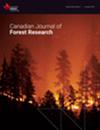地下和地上树木器官的不对称生长及其建筑关系综述
IF 1.5
3区 农林科学
Q2 FORESTRY
引用次数: 3
摘要
200多年来,许多森林生态学家一直对森林树木的生物学设计感兴趣,以抵御风和斜坡应力,从而改善树木的锚固和稳定性。结构和功能的不对称是生物力学设计的一个典型影响。这篇综述试图在对树冠、树干和根系不对称生长的观察总结的基础上,找到树木地下器官和地上器官之间的建筑连接。不对称的地上生长受到树种、年龄、邻里竞争、风、光照、坡度和海拔高度的复杂相互作用的影响。非对称地下发育取决于树种、年龄、树干倾斜、风、土壤和坡度。水分传导、养分分配、激素含量和光合作用速率的不均匀会影响地下器官和地上器官之间的结构机制关系。对根系(扶壁)方向变形的相互矛盾的观察揭示了多种因素综合作用的特殊突出性。未来的研究应侧重于全面了解不同树种的地下和地上建筑关系。我们的综述为根冠平衡在单个植物器官生物量分布中的含义提供了新的见解。本文章由计算机程序翻译,如有差异,请以英文原文为准。
Asymmetric growth of belowground and aboveground tree organs and their architectural relationships: a review
The issue of forest trees biologically designed to withstand wind and slope stresses for improving tree anchorage and stability has been of interest to many forest ecologists for over 200 years. Asymmetry in architecture and function is a typical effect of biomechanical design. This review tried to find the architectural connectivity between belowground and aboveground organs of a tree based on a summary of observations of the asymmetric growth of crown, trunk, and root system. The asymmetrical aboveground growth is influenced by a complex interaction of tree species, age, neighborhood competition, wind, lighting, slope, and elevation. The asymmetrical belowground development is dependent on tree species, age, trunk leaning, wind, soil, and slope. Uneven water conduction, nutrient allocation, hormone content, and photosynthesis rate can influence the relationship of architectural mechanisms between the belowground and aboveground organs. The contradictory observations on the directional deformations of the root system (buttresses) reveal the particular prominence of combined effects of multiple factors. Future research should focus on the comprehensive understanding of the belowground and aboveground architectural relationships of different tree species. Our review provides novel insights into the connotations of root–shoot balance in biomass distribution of the individual plant organs.
求助全文
通过发布文献求助,成功后即可免费获取论文全文。
去求助
来源期刊
CiteScore
4.20
自引率
9.10%
发文量
109
审稿时长
3 months
期刊介绍:
Published since 1971, the Canadian Journal of Forest Research is a monthly journal that features articles, reviews, notes and concept papers on a broad spectrum of forest sciences, including biometrics, conservation, disturbances, ecology, economics, entomology, genetics, hydrology, management, nutrient cycling, pathology, physiology, remote sensing, silviculture, social sciences, soils, stand dynamics, and wood science, all in relation to the understanding or management of ecosystem services. It also publishes special issues dedicated to a topic of current interest.

 求助内容:
求助内容: 应助结果提醒方式:
应助结果提醒方式:


